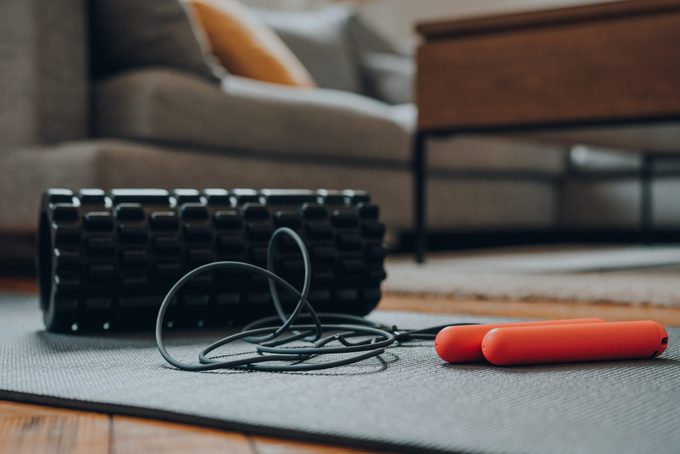6 Benefits of Jumping Rope That Will Inspire You to Try It

The playground toy makes a great at-home fitness tool. Here are the benefits of jumping rope, plus, tips to adopt a good form and add it to your home exercise routine.
When the cold weather and lack of sunshine test your exercise motivation, having easy, accessible exercise tools on hand can increase your chances of actually getting in a workout. The easier it is to just get up and move, the more likely you’ll be to do it. One of the most convenient and inexpensive pieces of exercise equipment for at-home workouts is a jump rope.
The unassuming jump rope is small, lightweight, and portable, which makes it a good addition to any home gym—even if your gym also doubles as your living space and office these days. But it’s also a great tool to use outside. If you’re short on space at home, you can grab your jump rope and head outdoors to any open space.
“Just being out in nature and getting fresh air is a mood-booster,” says Kira Stokes, celebrity trainer and creator of the Kira Stokes Fit app. “Any exercise modality we can take outside these days is something we should really look at as a positive form of exercise,” she says. A lot of people think of outdoor exercise as walking, running, and biking, but Stokes says that mixing up your cardio routine with some jumping rope is a great way to give your muscles and joints a bit of a break while still getting in a heck of a workout.
“Jumping rope really is so incredible,” Stokes says. Here are some of the health benefits of jumping rope and how to add it to your routine.
(Related: 14 Benefits of Walking for Just 15 Minutes)
Benefits of jumping rope
It’s best to clear any new physical activity with your doctor, especially if you have any preexisting heart or lung conditions. If you have joint problems or any pain or issues with your feet and ankles, knees, or hips, it’s also important to clear jumping rope with your doctor first, just to be safe. Here are some of the health benefits of jumping rope.
Cardiovascular conditioning
Jumping rope is first and foremost a great cardiovascular workout. It gets your heart rate up, which challenges your heart and lungs and helps make them stronger and healthier.
Doing intense exercise that gets your heart rate high, like jumping rope, also effectively burns calories. In fact, jumping rope burns calories at the same rate as running at an 8.5 mile-per-minute pace, according to The Adult Compendium of Physical Activities.
Coordination and agility
“The mind-body connection required when you’re jumping rope is one of the things that makes it so incredible,” says Stokes. At first, you might feel like you’re really bad at jumping rope. That you can’t get the rope and your jumps in sync no matter how hard you try. But the more you practice it, the more you’ll improve your coordination, which can help you in other workouts and just going about daily life.
“It improves coordination and agility but it takes time and practice,” says Stokes.
Portable and inexpensive
You can take a jump rope with you anywhere, which makes it a really convenient piece of equipment. As long as your ceilings are high enough, you can jump rope at home. Or, you can take it to the park, or simply jump in your driveway. You really can do it almost anywhere. And jump ropes are not expensive.
Strength workout
Jumping rope is primarily a cardio workout, but don’t be fooled: You’re also strengthening your arms, shoulders, calves, and core while you’re at it, Stokes says. Your arms and shoulders get some work, thanks to the upper-body’s job of holding and moving the rope. Also, your calves work every time you jump; and as long as you’re actively engaging your core throughout, you’ll get a sneaky core workout, too.
If you work out regularly already, you probably won’t be noticeably sore afterward, the way you would be after lifting heavy weights. However, there’s a good chance that anyone new to jumping rope will feel a slight burning sensation in the shoulders during the exercise.
(Related: You’d Be Surprised At What Actually Counts As Cardio)
Pelvic floor strengthening
Stokes says that many women tell her they don’t like jumping rope because it causes bladder leakage. For some people—most often women who have given birth—the pressure that jumping puts on the bladder, plus weakness in the pelvic floor muscles, can have this effect. But Stokes notes that over time, jumping rope can actually help strengthen the pelvic floor muscles if you focus on engaging your core the entire time.
“If your core is engaged, you should feel everything tighten up through the pelvis, so you’re essentially squeezing. That can help strengthen your pelvic floor,” Stokes says.
Bone density
Weight-bearing exercises, like jumping rope, are great for improving and maintaining bone strength. Similar to how muscles must be broken down to grow back stronger, when we subject our bones to some impact, it prompts the cells to rebuild and become denser. Stokes notes that jumping rope does put impact on the bones, but it’s a lower impact than some other weight-bearing exercises, like running.
“When you jump correctly, only an inch or two off the ground, it is relatively low-impact,” Stoke says. That means you can help boost your bone health without wearing out your joints as much—a win-win.
(Related: What Working from Home Does to Your Body)
How to shop for a jump rope
“Having the right rope makes a massive difference in whether or not you’ll become proficient in jumping rope,” says Stokes. The “right rope” is very subjective, though. When you’re just starting out, you’ll want to use a speed rope—which just means a thin, lightweight rope that doesn’t require a ton of strength to turn.
It’s also really important to make sure the rope is the right length for you. “Typically, when you stand on the rope, you want the handles to hit your armpits,” Stokes suggests. She personally uses a rope that is a little longer than that, so she recommends using that as a starting point and then adjusting the rope as you use it and learn what works best for you.

How to jump rope
Your elbows should be bent so that your forearms are parallel to the ground, and your elbows a few inches away from your body right by the sides of your ribcage. As you turn the rope, your elbows should remain in that spot by your side, says Stokes. “Nothing should move above the elbow when you’re jumping rope. The movement is all in the wrist,” she explains.
You also only need to jump about one or two inches off the ground. This will help minimize the pressure you put on your joints as you land.
Stokes suggests saying “jump” in your head every time the rope hits the ground. It sounds silly, but it’ll help get your body and mind in sync and improve the all-important coordination aspect.
Also, make sure you’re engaging your core the entire time, and avoid arching your back, says Stokes. Repetitively jumping in an arched-back position can put a lot of pressure on your spine and aggravate existing back issues or contribute to new ones. Think about squeezing and engaging your abdominal muscles and slightly tuck your tailbone toward the ground, so that your spine is straight and not overly arched.
(Related: 10 Pieces of Exercise Equipment to Buy for At-Home Workouts)
How to add it to your fitness routine
Like any other skill, getting good at jumping rope requires regular practice, says Stokes. She suggests working on it a little bit every day so that it’s not daunting. She also suggests starting small and progressing slowly.
“With jumping rope, you have to think just like running, in terms of progression. Start to implement it into your routine, and build up time and intensity slowly so that you don’t burn out on it or get frustrated by it,” Stokes says.
Find a space you’re comfortable in and give yourself 10 minutes to work on the skill of jumping rope. Don’t worry about speed, or efficiency, or calorie burn. Just focus on good form, making sure the rope feels like the right length, and working on the coordination of it. Try not to get frustrated, and stop practicing once the 10 minutes is up. Then, come back to it the next day.
Once you feel comfortable, you can add jumping rope to your routine a few ways. You can do a straight jump rope-focused workout that combines jumping rope with other conditioning drills in between. You can add short jump rope intervals to your strength training workout.
Stokes recommends three minutes of jumping rope in between each new circuit to turn it into a more at-home HIIT-style workout. You can also add it to a bodyweight workout, jumping for a minute between exercises or at the end of each circuit, to get a heart rate boost every now and then.
The beauty of jumping rope is that it’s versatile, basic, and really effective. It’s really a great skill—and tool—to have in your back pocket.
Next: Why Everyone Is Using a Foam Roller Right Now (and You Should Too)




